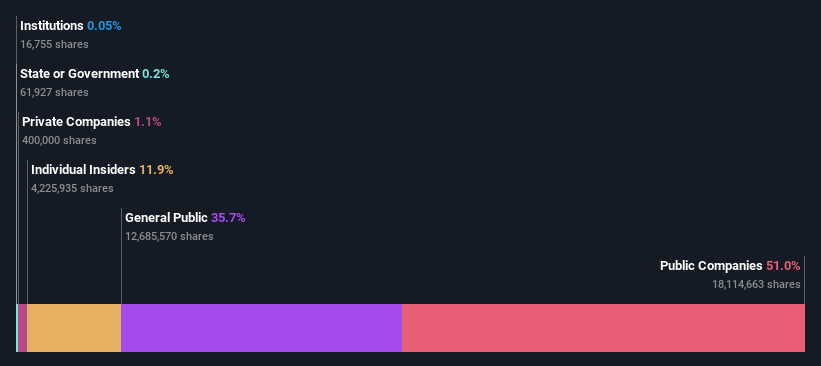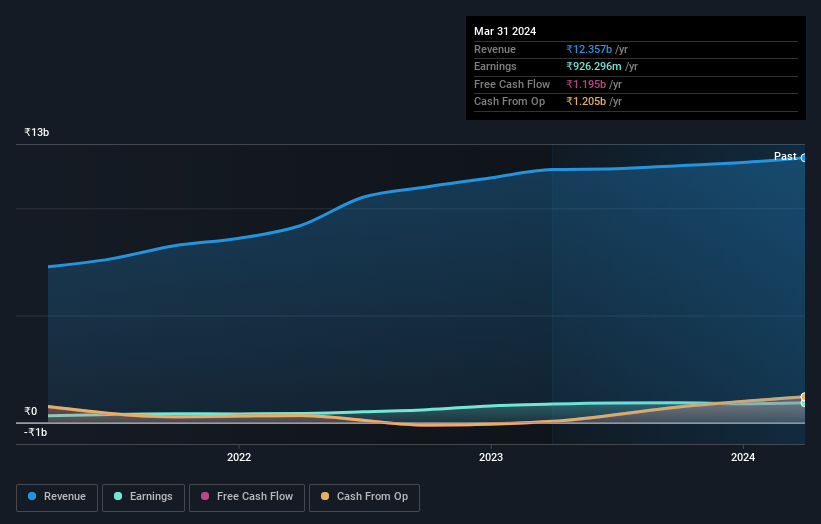- India
- /
- Electronic Equipment and Components
- /
- NSEI:DLINKINDIA
D-Link (India) Limited's (NSE:DLINKINDIA) biggest owners are public companies who got richer after stock soared 19% last week
Key Insights
- The considerable ownership by public companies in D-Link (India) indicates that they collectively have a greater say in management and business strategy
- The largest shareholder of the company is D-Link Corporation with a 51% stake
- Insiders have been selling lately
To get a sense of who is truly in control of D-Link (India) Limited (NSE:DLINKINDIA), it is important to understand the ownership structure of the business. And the group that holds the biggest piece of the pie are public companies with 51% ownership. Put another way, the group faces the maximum upside potential (or downside risk).
As a result, public companies collectively scored the highest last week as the company hit ₹20b market cap following a 19% gain in the stock.
Let's delve deeper into each type of owner of D-Link (India), beginning with the chart below.
See our latest analysis for D-Link (India)

What Does The Lack Of Institutional Ownership Tell Us About D-Link (India)?
Institutional investors often avoid companies that are too small, too illiquid or too risky for their tastes. But it's unusual to see larger companies without any institutional investors.
There are many reasons why a company might not have any institutions on the share registry. It may be hard for institutions to buy large amounts of shares, if liquidity (the amount of shares traded each day) is low. If the company has not needed to raise capital, institutions might lack the opportunity to build a position. On the other hand, it's always possible that professional investors are avoiding a company because they don't think it's the best place for their money. D-Link (India) might not have the sort of past performance institutions are looking for, or perhaps they simply have not studied the business closely.

We note that hedge funds don't have a meaningful investment in D-Link (India). D-Link Corporation is currently the largest shareholder, with 51% of shares outstanding. With such a huge stake in the ownership, we infer that they have significant control of the future of the company. Mukesh Lulla is the second largest shareholder owning 6.6% of common stock, and Ashish Kacholia holds about 2.1% of the company stock.
Researching institutional ownership is a good way to gauge and filter a stock's expected performance. The same can be achieved by studying analyst sentiments. We're not picking up on any analyst coverage of the stock at the moment, so the company is unlikely to be widely held.
Insider Ownership Of D-Link (India)
The definition of an insider can differ slightly between different countries, but members of the board of directors always count. Management ultimately answers to the board. However, it is not uncommon for managers to be executive board members, especially if they are a founder or the CEO.
Insider ownership is positive when it signals leadership are thinking like the true owners of the company. However, high insider ownership can also give immense power to a small group within the company. This can be negative in some circumstances.
It seems insiders own a significant proportion of D-Link (India) Limited. Insiders have a ₹2.4b stake in this ₹20b business. It is great to see insiders so invested in the business. It might be worth checking if those insiders have been buying recently.
General Public Ownership
With a 36% ownership, the general public, mostly comprising of individual investors, have some degree of sway over D-Link (India). While this size of ownership may not be enough to sway a policy decision in their favour, they can still make a collective impact on company policies.
Public Company Ownership
We can see that public companies hold 51% of the D-Link (India) shares on issue. This may be a strategic interest and the two companies may have related business interests. It could be that they have de-merged. This holding is probably worth investigating further.
Next Steps:
It's always worth thinking about the different groups who own shares in a company. But to understand D-Link (India) better, we need to consider many other factors. To that end, you should be aware of the 3 warning signs we've spotted with D-Link (India) .
If you would prefer check out another company -- one with potentially superior financials -- then do not miss this free list of interesting companies, backed by strong financial data.
NB: Figures in this article are calculated using data from the last twelve months, which refer to the 12-month period ending on the last date of the month the financial statement is dated. This may not be consistent with full year annual report figures.
New: Manage All Your Stock Portfolios in One Place
We've created the ultimate portfolio companion for stock investors, and it's free.
• Connect an unlimited number of Portfolios and see your total in one currency
• Be alerted to new Warning Signs or Risks via email or mobile
• Track the Fair Value of your stocks
Have feedback on this article? Concerned about the content? Get in touch with us directly. Alternatively, email editorial-team (at) simplywallst.com.
This article by Simply Wall St is general in nature. We provide commentary based on historical data and analyst forecasts only using an unbiased methodology and our articles are not intended to be financial advice. It does not constitute a recommendation to buy or sell any stock, and does not take account of your objectives, or your financial situation. We aim to bring you long-term focused analysis driven by fundamental data. Note that our analysis may not factor in the latest price-sensitive company announcements or qualitative material. Simply Wall St has no position in any stocks mentioned.
Have feedback on this article? Concerned about the content? Get in touch with us directly. Alternatively, email editorial-team@simplywallst.com
About NSEI:DLINKINDIA
D-Link (India)
Engages in the marketing and distribution of D-Link branded networking products for consumers, small businesses, medium to large-sized enterprises, and service providers in India.
Flawless balance sheet established dividend payer.
Similar Companies
Market Insights
Community Narratives



